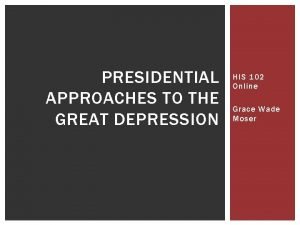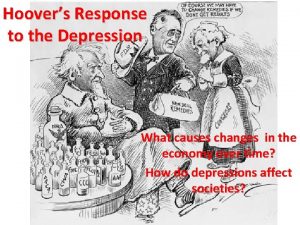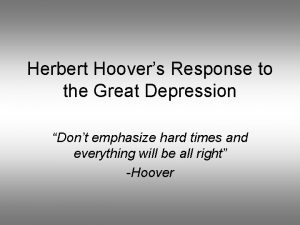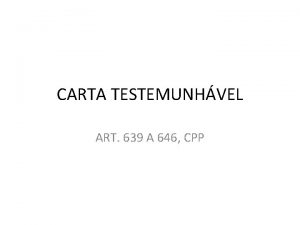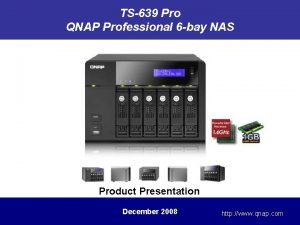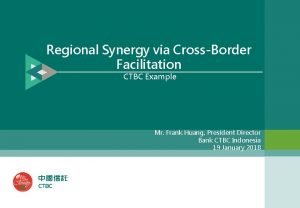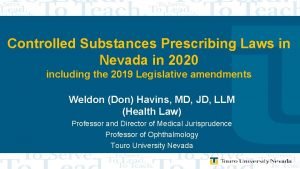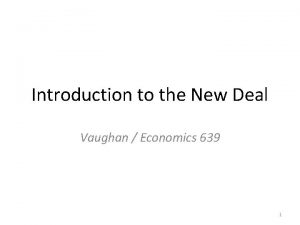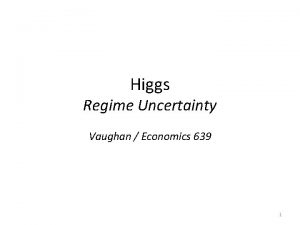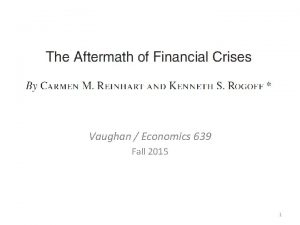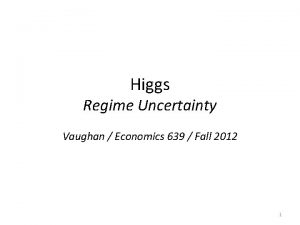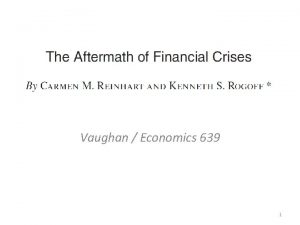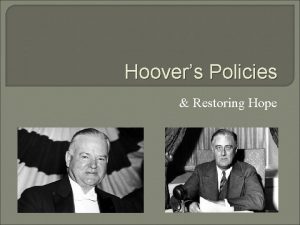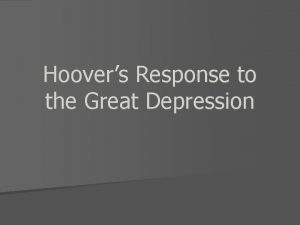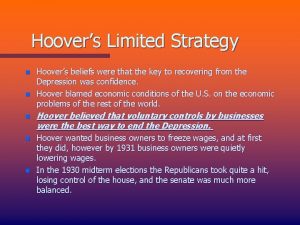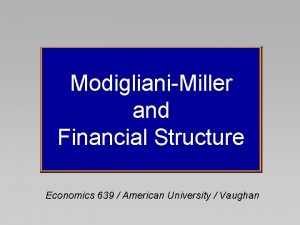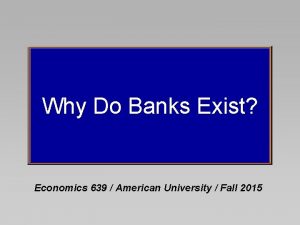Hoovers Economic Policy Economics 639 American University Vaughan












- Slides: 12

Hoover’s Economic Policy Economics 639 / American University / Vaughan 1 - 12

Hoover: “Father of New Deal” Traditional Criticism of Hoover • Laissez faire ideologue • Did nothing to address Depression, apart from foolishly trying to balance budget with tax increases. Took election of FDR to get economic policy going in right direction 2 - 12

Hoover as “Father of New Deal” Truth about Hoover • Committed interventionist throughout government career. • Relied on “state of the art” economic thinking. • Initial response to stock-market crash/recession was pressure on businesses not to cut wages (more later). • Followed up by almost doubling real federal spending between 1929 and 1933 (though much of real increase traceable to falling prices). – Percentage of spending financed by deficits in 1931 and 1932 larger than any year from 1933 -1941 (under FDR). 3 - 12

Hoover: “Father of New Deal” Truth about Hoover (continued) • Signed Smoot-Hawley Tariff (more later). • Created RFC (Reconstruction Finance Corporation) to recapitalize banks – precursor to TARP. • Created Federal Home Loan Bank System as “discount facility” for thrift institutions. • Responsible for Revenue Act of 1932, which dramatically raised marginal tax rates, particularly on high earners. – Later, Keynesians criticized negative impact on aggregate demand. – Modern “supply side” conservatives criticized negative impact on aggregate supply. – Macroeconomic impact was probably small, though measure did make sense as measure to bolster gold standard. 4 - 12

Ohanian: Hoover and Start of Depression • U. S. industry was significantly depressed before banking panics/monetary contraction began. For example, by November 1930 (when first panic started), per-capita industrial hours worked were down 30%. • Evidence suggests real wages substantially exceeded market-clearing levels. Why didn’t market forces reduce wages, increase hours worked, and boost output? – Hoover met major industrial leaders in late 1929 to pressure not to cut wages. President argued maintaining wages would minimize severity of downturn and help him keep peace with labor. He also advised firms to share work among employees rather than rely on layoffs. Hoover then asked labor leaders to forego strikes and withdraw requests for higher wages. – But declining prices/productivity, coupled with Hoover’s wage-fixing program, significantly increased industrial labor costs. As downturn intensified, industry leaders asked Hoover for wage cuts proportional to deflation. Hoover declined, despite increasing criticism of his program. Many large firms didn’t cut wages until fall 1931; by then industrial hours worked were down nearly 40%. • Hoover’s program significantly dampens output in Ohanian’s model – reducing real GDP by 18 percent by end of 1931 (about 2/3 rds of Depression at that stage). 5 - 12

Ohanian: Hoover and Start of Depression Per capita Manufacturing Hours and Money Supply NOTE: Hours down nearly 30% from October 1929 to October 1930 without material change in money supply. Index: January 1929 = 100 for Both Series 6 - 12

Impact of Hoover’s Wage Maintenance Program Long-Run Aggregate Supply Price Level (Potential Output) Short-Run Aggregate Supply (SR-AS 1) SR-AS 2 (with lower nominal wages) P 1 B Absent another shock, unemployment caused by AD↓ causes nominal wages to fall. Decline in nominal wages shifts SR-AS curve to right, driving prices down and real output up until potential output is restored. But: Hoover’s policy prevented falling wages from restoring full employment. A P 2 P 3 C Aggregate Demand (AD)1 Y 2 Y 1= Yp = Y 3 AD 2 – Tight Money + Impact of Uncertainty/Indebtedness on Consumer Spending. Real Output 7 - 12

Smoot Hawley • Smoot Hawley (SH) not anti-depression measure. – Imposed in June 1930, but work began before cyclical peak in August 1929. • Hoover had reasonable economic (as well as political) arguments for signing SH, though tariffs ended up higher than he wanted. – Supporting farm income and preserving high wages, he thought, would promote consumption and, thereby, production. – Much of New Deal based on similar “underconsumption thesis. ” • SH not unprecedented tariffs – just restored them to near-1900 levels. • SH one factor among others (such as world-wide high unemployment), contributing to break-out of protectionism. But trade was small part of U. S. GDP, so even if SH were principal cause of observed decline in imports/exports, macroeconomic impact was marginal. 8 - 12

Trade Sector Going into Depression Small Relative to U. S. GDP Foreign sector (measured by imports / exports) now nearly three times 1929 level! 9 - 12

SH: Key Points (continued) • If SH did discourage imports, most of effect came from deflation, not increase in nominal duties. And most of observed decline in imports (exports) stemmed from falling incomes in U. S. and its export markets. – Recent Argument: SH depressed economy through indirect channel – resulting trade war hurt U. S. farm exports and contributed to 1930 -33 bank failures. • FDR campaigned against SH, but did not make repeal a priority. – Trade policy subordinated to other income-boosting programs (NIRA and AAA) in Hundred Days. • Even though Reciprocal Trade Agreements Act (RTAA) became law in 1934, U. S. didn’t strike agreements with most of principal trading partners until late 1930 s. By World War II, agreements cut only ½ of nominal SH duties. – Upshot: Roll-back made negligible contribution to recovery in 1930 s. 10 - 12

Bottom Line • SH depressed economic activity, but macroeconomic effect was small. • ASIDE: Statistical vs. economic significance – Statistical significance: Given sample size, one can discount possibility observed relationship is random. • With large enough sample size, everything statistically significant. – Economic significance: Assuming estimated relationship is “true, ” is it large – that is, economically meaningful? 11 - 12

Concluding Thoughts Why does Hoover get such a bad rap? • Expectations about Hoover’s ability to manage Great Depression probably unrealistic. • FDR master of era’s new media (radio). • FDR successfully led U. S. through WWII (and died while incredibly popular). • Hoover’s bitterness over 1932 loss led him to spend much of his retirement attacking FDR/New Deal. • FDR actively courted academics – “the Brains Trust. ” They ultimately wrote the history. 12 - 12
 School of business and economics maastricht
School of business and economics maastricht Herbert hoover great depression political cartoon
Herbert hoover great depression political cartoon Hoovers response to the depression
Hoovers response to the depression J edgar hoovers lover
J edgar hoovers lover What was hoover's response to the great depression
What was hoover's response to the great depression Definisie van n pa
Definisie van n pa Subsisir
Subsisir I-fss-639
I-fss-639 Qnap ts-639
Qnap ts-639 Ctbc 639
Ctbc 639 Nevada controlled substance list
Nevada controlled substance list Brampton sustainability metrics
Brampton sustainability metrics Clasificacion vaughan williams
Clasificacion vaughan williams

